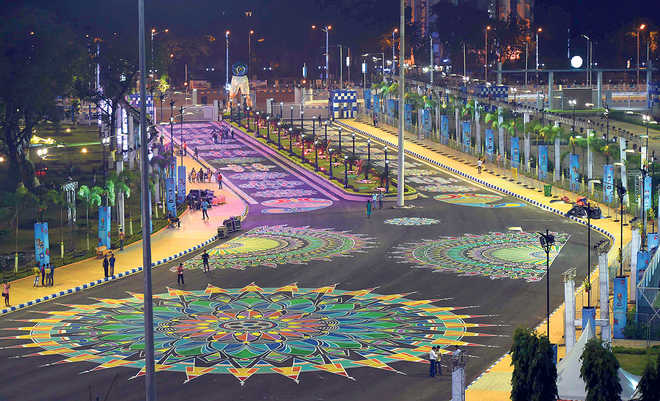
The longest intricate alpana design on Salt Lake Road
Ranjita Biswas
In February this year, nearly 1,000 students (from classes six to eleven) of a school in eastern Kolkata selected a stretch of road as their canvas to create colourful street floor art, or alpana (also alpona), as part of the Saraswati Puja celebrations. Then this April, NSHM Knowledge Campus, Kolkata, held an alpana drawing competition titled Kalpona Theke Alpona (from imagination to alpana). It was held as a part of the celebration of the Museum Week. The celebrations also included screening of a documentary Broto Alpona on the sacred art, which is practiced during auspicious occasions in Bengali culture.
Go back a year and half back when during the Durga Puja festival, the locals woke up to an astounding sight in south Kolkata. A puja organised by the local Samaj Sevi Sangha welcomed pandal-hoppers to ‘the longest alpana’ in town on Lake View Road. The one-and-a-half km stretch of intricate alpana design in multiple colours was inaugurated by Bengali actor Prosenjit Chatterjee. The massive floor art was painted by about 325 art school students in 24 hours flat. Of course, paint brushes had to be used to do the huge drawing and a paint company sponsored it too. The same year, a similar huge alpana was created at the Salt Lake Stadium when the city hosted the under-17 FIFA World Cup Football. Bengal’s humble decorative floor art has truly stepped out into public spaces.
Says Sreemati Saha, a Kolkatan who lives in America, “When I saw the Durga Puja décor with alpana at a website I was both nostalgic and astounded. When I lived there, we girls drew alpana on the floor during Lakshmi Puja at home. But I never imagined that the craft would take on this new avatar.” She adds that even in America, and elsewhere in the world where Bengali ex-pats organise the autumn festival, alpana is still drawn keeping with the norms.
Traditionally done in white, alpanas are drawn in uninterrupted lines and done freehand by fingers. Alpana falls into the category of folk art, its origin going back to a hoary past.
But its recognition as an ‘art’, elevating it from a common chore of village women during auspicious occasions owes a lot to Nobel Laureate Rabindranath Tagore and his brainchild, Santiniketan. The fascinating journey of alpana from thatched cottages to a high art form is chronicled by Swati Ghosh in her book, Design movement in Tagore’s Santiniketan: Alpana — An Experiment in Aestheticism.
At Selaidaha, his country home of the zemindari (now in Bangladesh), Tagore became interested in folk culture through interaction with the villagers. He found that many folk art and handicrafts were on the wane because of lack of demand by people. He tried to rescue and revive these art forms, alpana being one of them. He found the art drawn on brown papers by village women and started collecting them. As Tagore gave shape to his dream institution Visva Bharati in Santiniketan, he introduced at Kala Bhavana’s repertoire, the floor art of alpana, sometimes also drawn on walls. Alpana became an integral part of Santiniketan’s decorations. There are beautiful examples of how folk art and modern sensibility merge together in many elaborate works in evidence in Santiniketan. Today, these are inspiring a new interest in art circles in towns and cities, with experiments going on how to keep the tradition alive in modern age.
Tagore also encouraged commercial production of artistic objects with twin purposes, to keep rural art alive and also to make the poor artisans economically independent. The popular Santiniketan art products, like leather bags, scarfs, stoles bear the stamp of alpana art and figure in the shopping list of must-buys for visitors to West Bengal.
Folk arts like alpana, after all, are a tribute to man’s innate aspiration to create beauty. It needs to be discovered anew and replicated because its age-old appeal does not wane.
A folk art for all regions
Drawing auspicious motifs, especially on the floor, is a practice seen across India among various communities. Writes Stephen P. Huyler (Painted Prayers, Women’s Art in Village India): “It is possible that this tradition of ornamentation has been passed down from mother to daughter for thousands of years. It forms a common thread that unites the innumerable cultures of India, people who are otherwise divided by race, language, caste, religion, and occupation. In a society dominated by men, it is the inheritance and artistic expression of the woman through their own techniques and symbols — prayers painted or ‘written’ from the heart.”
Thus we find floor art called mandana in Rajasthan, rangoli in Maharashtra, sathia in Gujarat, chowkpurana or sonarakhna in Uttar Pradesh, likhnu in Himachal Pradesh, apna in Almora and Nainital region, kolam in Tamil Nadu, muggulu in Andhra Pradesh, pakhamba in Manipur and jinnuti in Odisha.
All these words have roots in vernacular languages but some, experts say, go back to pre-Aryan era. For instance, mandna in Rajasthan comes from Mandan — to decorate. Rangoli on the other hand originates in the Sanskrit word of rangavalli, which means a creeper drawn with colours. Interestingly the word alpana or alpona is believed to have derived from the Sanskrit word ‘alimpan’ which means ‘to plaster’ or ‘to coat with’ — the art of making ‘ails’ or embankments based on the belief that these decorative paintings kept the habitats safe and prosperous through their magical symbols.
Art historians and archaeologists observe that the first visual traces of floor paintings are found in one of the seals of Mohenjo daro with geometric symbols resembling a mandala which is drawn while worshiping women deities.



























